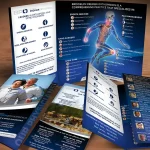In today’s digital age, having a strong online presence is crucial for businesses and individuals alike. A well-designed website that is optimized for search engines (SEO) can significantly increase web traffic, leading to more visibility, engagement, and potential customers. This blog post aims to provide a comprehensive guide on the importance of website design and SEO for maximizing web traffic. It will delve into various aspects of website design and SEO, offering tips and strategies to help readers enhance their online presence.
Key Takeaways
- Website design and SEO are crucial for maximizing web traffic.
- A user-friendly website design enhances user experience and improves SEO ranking.
- Optimizing website speed is important for better user engagement and search engine ranking.
- High-quality content improves website visibility and SEO ranking.
- Keyword research and on-page optimization are essential for effective SEO strategy.
Understanding the Importance of Website Design and SEO for Maximizing Web Traffic
Website design and SEO are closely intertwined and play a vital role in maximizing web traffic. Website design encompasses the visual elements, layout, and user experience of a website, while SEO focuses on optimizing the website’s content and structure to rank higher in search engine results.
A well-designed website not only attracts visitors but also keeps them engaged. A visually appealing and user-friendly design can enhance the overall user experience, making it easier for visitors to navigate through the site and find the information they are looking for. This positive user experience leads to longer visit durations, lower bounce rates, and increased chances of conversions.
On the other hand, SEO ensures that your website is easily discoverable by search engines. By optimizing your website’s content with relevant keywords, meta tags, and headings, you increase its visibility in search engine results pages (SERPs). Higher rankings in SERPs mean more organic traffic to your website, as users are more likely to click on websites that appear on the first page of search results.
Creating a User-Friendly Website Design to Enhance User Experience
User experience (UX) is a critical factor in website design as it directly impacts how visitors interact with your site. A positive UX can lead to increased engagement, repeat visits, and higher chances of conversions. Here are some tips for creating a user-friendly website design:
1. Simplify Navigation: Ensure that your website’s navigation is intuitive and easy to use. Use clear and concise labels for your menu items and organize your content in a logical manner.
2. Optimize Page Load Speed: Slow-loading websites can frustrate visitors and lead to higher bounce rates. Optimize your website’s speed by compressing images, minifying code, and using caching techniques.
3. Use Responsive Design: With the increasing use of mobile devices, it is essential to have a responsive website design that adapts to different screen sizes. This ensures that your website looks and functions well on all devices.
4. Prioritize Readability: Choose fonts, colors, and font sizes that are easy to read. Use sufficient white space and break up content into smaller paragraphs or bullet points for better readability.
5. Include Clear Call-to-Actions: Guide visitors towards desired actions by including clear and prominent call-to-action buttons or links. Make it easy for visitors to contact you, make a purchase, or sign up for a newsletter.
Optimizing Website Speed for Better User Engagement and Search Engine Ranking
Website speed is not only crucial for user engagement but also plays a significant role in search engine ranking. Slow-loading websites can lead to higher bounce rates, as visitors tend to abandon sites that take too long to load. Additionally, search engines like Google consider page load speed as a ranking factor. Here are some tips for optimizing website speed:
1. Compress Images: Large image files can significantly slow down your website. Compress images without compromising quality using tools like Adobe Photoshop or online image compressors.
2. Minify Code: Remove unnecessary characters, spaces, and line breaks from your HTML, CSS, and JavaScript files to reduce their size. This helps in faster loading times.
3. Enable Browser Caching: Browser caching allows repeat visitors to load your website faster by storing static files locally on their device. Enable caching by adding caching headers to your server configuration.
4. Use Content Delivery Networks (CDNs): CDNs distribute your website’s static files across multiple servers worldwide, reducing the distance between the user and the server. This results in faster loading times for visitors from different locations.
5. Optimize Server Response Time: Ensure that your web hosting provider has fast and reliable servers. Minimize server response time by optimizing database queries, using caching plugins, and choosing a reputable hosting provider.
Crafting High-Quality Content to Improve Website Visibility and SEO Ranking
High-quality content is the backbone of any successful SEO strategy. It not only improves website visibility but also helps in establishing authority and credibility in your industry. Here are some tips for crafting high-quality content:
1. Conduct Keyword Research: Identify relevant keywords that your target audience is searching for. Use keyword research tools like Google Keyword Planner or SEMrush to find keywords with high search volume and low competition.
2. Create Engaging Headlines: Craft compelling headlines that grab the reader’s attention and entice them to click on your content. Use power words, numbers, and emotional triggers to make your headlines more appealing.
3. Write for Your Audience: Understand your target audience’s needs, preferences, and pain points. Create content that addresses their specific challenges and provides valuable solutions.
4. Use Subheadings and Bulleted Lists: Break up your content into smaller sections using subheadings and bulleted lists. This makes it easier for readers to scan through the content and find the information they are looking for.
5. Incorporate Visuals: Use relevant images, infographics, videos, or charts to enhance your content. Visuals not only make your content more engaging but also help in conveying complex information more effectively.
Conducting Keyword Research and On-Page Optimization for Effective SEO Strategy
Keyword research and on-page optimization are essential components of an effective SEO strategy. By conducting keyword research, you can identify the keywords and phrases that your target audience is using to search for information related to your industry. On-page optimization involves optimizing your website’s content, meta tags, headings, and URLs with these keywords. Here are some tips for conducting keyword research and on-page optimization:
1. Use Keyword Research Tools: Utilize keyword research tools like Google Keyword Planner, SEMrush, or Ahrefs to find relevant keywords with high search volume and low competition. These tools provide insights into keyword trends, search volume, and competition levels.
2. Focus on Long-Tail Keywords: Long-tail keywords are longer and more specific phrases that have lower search volume but higher conversion rates. Targeting long-tail keywords allows you to reach a more targeted audience and increase the chances of conversions.
3. Optimize Meta Tags: Include your target keywords in the meta title and meta description tags of your web pages. These tags appear in search engine results and can significantly impact click-through rates.
4. Use Heading Tags: Structure your content using heading tags (H1, H2, H3, etc.) to indicate the hierarchy of information on your page. Include relevant keywords in your headings to improve SEO.
5. Optimize URLs: Create SEO-friendly URLs that include relevant keywords and are easy to read. Avoid using long strings of numbers or special characters in your URLs.
Building High-Quality Backlinks to Boost Website Authority and SEO Ranking
Backlinks are an essential factor in SEO as they indicate the credibility and authority of your website. Search engines consider backlinks as “votes” from other websites, indicating that your content is valuable and trustworthy. Here are some tips for building high-quality backlinks:
1. Create Valuable Content: Focus on creating high-quality content that provides value to your target audience. When you produce valuable content, other websites are more likely to link back to it.
2. Guest Blogging: Write guest posts for reputable websites in your industry. Include a link back to your website in the author bio or within the content itself. Guest blogging not only helps in building backlinks but also increases your visibility and establishes you as an industry expert.
3. Reach Out to Influencers: Identify influencers or thought leaders in your industry and reach out to them. Offer to collaborate on content or ask for their opinion on a topic related to your industry. If they find your content valuable, they may link back to it or share it with their audience.
4. Participate in Online Communities: Engage in online communities, forums, or social media groups related to your industry. Share valuable insights, answer questions, and provide helpful resources. This can lead to natural backlinks as other community members find your contributions valuable.
5. Monitor Competitor Backlinks: Use tools like Ahrefs or Moz to analyze the backlink profiles of your competitors. Identify websites that are linking to them and reach out to those websites to request a link back to your content if it is relevant.
Leveraging Social Media Platforms to Drive Traffic and Improve SEO Ranking
Social media platforms have become powerful tools for driving traffic and improving SEO ranking. By leveraging social media effectively, you can increase brand visibility, engage with your audience, and attract more visitors to your website. Here are some tips for leveraging social media platforms:
1. Choose the Right Platforms: Identify the social media platforms that are most relevant to your target audience. Focus on building a strong presence on those platforms rather than spreading yourself too thin across multiple platforms.
2. Optimize Your Profiles: Optimize your social media profiles by including relevant keywords in your bio, description, and posts. Use high-quality images and consistent branding across all platforms.
3. Share Valuable Content: Share valuable content from your website on social media platforms. This can include blog posts, videos, infographics, or any other content that provides value to your audience. Encourage social sharing by including social sharing buttons on your website.
4. Engage with Your Audience: Respond to comments, messages, and mentions on social media promptly. Engage in conversations, ask questions, and encourage user-generated content. Building a strong relationship with your audience can lead to increased brand loyalty and more traffic to your website.
5. Collaborate with Influencers: Identify influencers or micro-influencers in your industry and collaborate with them on social media campaigns or content creation. Influencers have a dedicated following and can help in increasing your brand visibility and driving traffic to your website.
Implementing Local SEO Strategies to Attract Local Customers and Boost Web Traffic
For businesses targeting a local audience, implementing local SEO strategies is crucial. Local SEO focuses on optimizing your website and online presence to attract customers from a specific geographic location. Here are some tips for implementing local SEO strategies:
1. Optimize Google My Business: Create and optimize your Google My Business listing. Provide accurate and up-to-date information about your business, including address, phone number, website URL, and business hours. Encourage customers to leave reviews on your Google My Business listing.
2. Include Local Keywords: Incorporate local keywords in your website’s content, meta tags, headings, and URLs. This helps search engines understand the geographic relevance of your website.
3. Build Citations: Citations are online mentions of your business’s name, address, and phone number (NAP) on other websites or directories. Ensure that your NAP information is consistent across all citations.
4. Get Reviews: Encourage customers to leave reviews on platforms like Google My Business, Yelp, or industry-specific review sites. Positive reviews not only improve your online reputation but also help in attracting more local customers.
5. Create Local Content: Create content that is relevant to your local audience. This can include blog posts, videos, or guides that provide information about local events, attractions, or resources.
Analyzing Website Metrics to Monitor Performance and Optimize SEO Strategy
Analyzing website metrics is essential for monitoring the performance of your website and optimizing your SEO strategy. By tracking key metrics, you can identify areas for improvement and make data-driven decisions. Here are some tips for analyzing website metrics:
1. Use Google Analytics: Install Google Analytics on your website to track various metrics like website traffic, bounce rate, average session duration, and conversion rates. Set up goals and funnels to track specific actions or conversions on your website.
2. Monitor Organic Search Traffic: Keep an eye on the organic search traffic to your website. Analyze which keywords are driving the most traffic and identify opportunities for improvement.
3. Track User Engagement: Monitor metrics like bounce rate, average session duration, and pages per session to understand how users are engaging with your website. Identify pages with high bounce rates and optimize them for better user engagement.
4. Analyze Conversion Rates: Track conversion rates for specific actions on your website, such as form submissions, newsletter sign-ups, or purchases. Identify pages or steps in the conversion funnel that have low conversion rates and optimize them for better results.
5. Set Up Custom Dashboards: Create custom dashboards in Google Analytics to track specific metrics that are relevant to your business goals. This allows you to have a quick overview of the most important metrics without having to dig through multiple reports.
Staying Up-to-Date with the Latest Trends and Best Practices in Website Design and SEO
Website design and SEO are constantly evolving fields, with new trends and best practices emerging regularly. It is crucial to stay up-to-date with these changes to ensure that your website remains competitive and optimized for search engines. Here are some tips for staying up-to-date:
1. Follow Industry Blogs and Websites: Subscribe to industry blogs and websites that provide updates on website design and SEO trends. Stay informed about the latest developments, algorithm updates, and best practices.
2. Attend Webinars and Conferences: Participate in webinars or attend conferences related to website design and SEO. These events provide valuable insights, networking opportunities, and access to industry experts.
3. Join Online Communities: Engage in online communities, forums, or social media groups where professionals discuss website design and SEO topics. Participate in discussions, ask questions, and share your knowledge.
4. Continuously Educate Yourself: Invest in your professional development by taking online courses, reading books, or watching tutorials related to website design and SEO. Stay curious and open to learning new techniques and strategies.
5. Test and Experiment: Don’t be afraid to test new ideas or experiment with different strategies. Keep track of the results and analyze the impact on your website’s performance. This allows you to adapt your approach based on what works best for your specific situation.
In conclusion, website design and SEO are crucial for maximizing web traffic and achieving online success. A well-designed website that is optimized for search engines can significantly increase visibility, engagement, and potential customers. By creating a user-friendly website design, optimizing website speed, crafting high-quality content, conducting keyword research, building high-quality backlinks, leveraging social media platforms, implementing local SEO strategies, analyzing website metrics, and staying up-to-date with the latest trends and best practices, you can ensure that your website is easily discoverable by search engines and provides a positive user experience. This will ultimately lead to higher rankings in search engine results pages, increased organic traffic, and improved conversion rates. Additionally, regularly monitoring and analyzing website metrics will allow you to identify areas for improvement and make data-driven decisions to further optimize your website’s performance. By investing time and effort into website design and SEO, you can position your business for long-term success in the competitive online landscape.
If you’re interested in learning more about website design and SEO, you may want to check out this informative article on the best web design company in Sunnyside, NY. This article provides valuable insights into the importance of professional web design and how it can impact your online presence. Whether you’re a small business owner or an individual looking to establish a strong online presence, this article offers helpful tips and recommendations. To read more about it, visit https://brachadesigns.com/best-web-design-company-sunnyside-ny/.
FAQs
What is website design?
Website design refers to the process of creating the visual layout and user interface of a website. It involves the use of various design elements such as color, typography, images, and layout to create an aesthetically pleasing and functional website.
What is SEO?
SEO stands for Search Engine Optimization. It is the process of optimizing a website to improve its visibility and ranking on search engine results pages (SERPs). This involves various techniques such as keyword research, on-page optimization, link building, and content creation.
Why is website design important for SEO?
Website design plays a crucial role in SEO because it affects the user experience and the ability of search engines to crawl and index a website. A well-designed website with a clear structure, easy navigation, and fast loading speed can improve user engagement and reduce bounce rates, which are important ranking factors for search engines.
What are some important elements of website design for SEO?
Some important elements of website design for SEO include a clear and concise site structure, easy navigation, fast loading speed, mobile responsiveness, and optimized images and videos. These elements can improve user experience and help search engines crawl and index a website more effectively.
What are some common SEO mistakes in website design?
Some common SEO mistakes in website design include using flash or other technologies that are not search engine friendly, using duplicate content, having a slow loading speed, using non-descriptive URLs, and not optimizing images and videos. These mistakes can negatively impact a website’s visibility and ranking on search engine results pages.















0 Comments